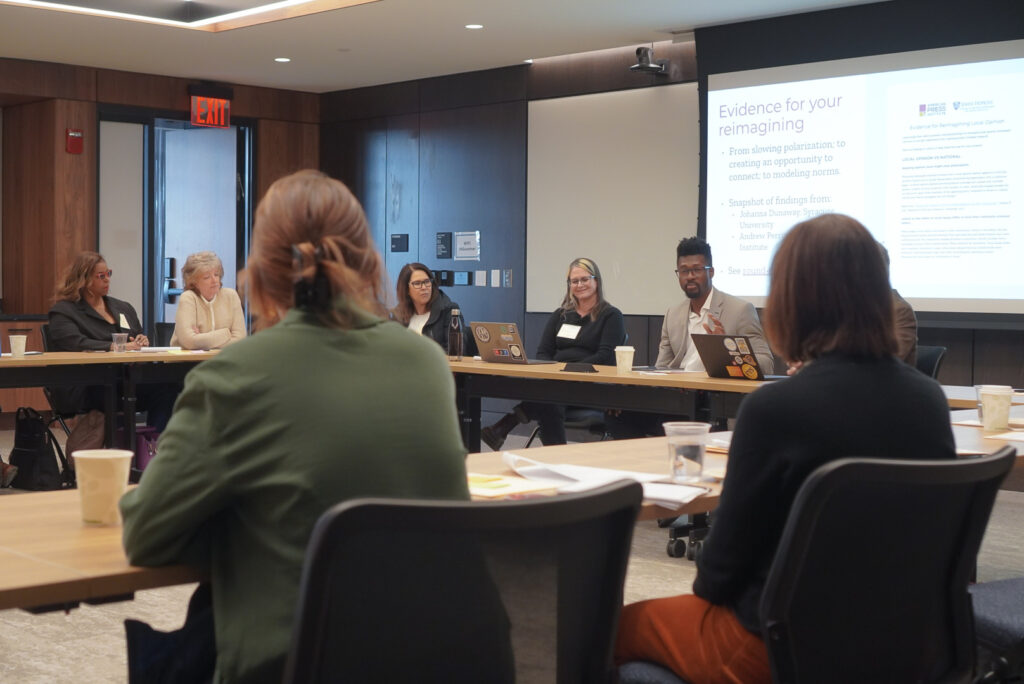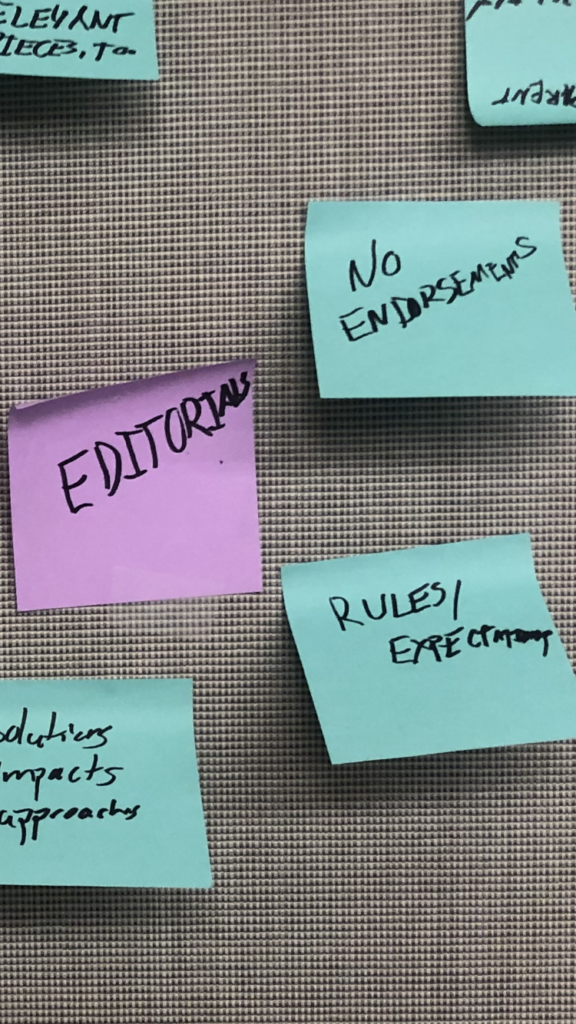Kevin Loker, senior director for program operations and partnerships at the American Press Institute, recently completed a visiting fellowship with the SNF Agora Institute at Johns Hopkins University. His project explored the reimagining of local opinion journalism — and philanthropy’s role in the trend. We’ve published excerpts from a report publishing soon: its introduction, a framework for what local opinion does for democracy and now this: a rundown of challenges and opportunities for local media and funders interested in this work.
***
We knew from American Press Institute programming over the last five years that opinion editors were keenly interested in an opinion section’s connection to sustainability. And the interest went well-beyond subscriptions.

The 25-person fellowship convening brought together local news leaders from both for-profit and nonprofit news, and alongside researchers and philanthropists.
Through conversations, it became clear experimentation with philanthropy and local opinion journalism was happening across the country, but those involved were not connected enough to begin learning from one another. The SNF Agora Visiting Fellowship, including bringing opinion editors, philanthropists and researchers together in March 2024, helped begin to address that.
Our Washington, D.C. event surfaced many ideas and questions featured in this report, including challenges of local media and stakeholders pursuing such projects. These include:
- Time and capacity
- Navigating the role of philanthropy in local journalism today
- Specific considerations when mixing opinion and philanthropy
- Gaining facilitative skills as jobs evolve
Time and capacity
The U.S. news landscape has seen substantial change over the past decade. Northwestern Local News Initiative’s State of Local Journalism for 2023 said the country has lost a third of its newspapers and two-thirds of its newspaper journalists since 2005. Many dailies, it said, have less than a fifth of the journalists they had on staff in 2005.
Opinion editors have felt those cuts, too. While the cuts have affected their work alongside everyone else’s, expectations around the scale of what can be published have not always kept pace.
I asked several opinion editors to expand this conversation on their time and capacity, including any staffing and/or resource changes that have affected their local opinion journalism over the past decade.
Said one opinion editor at a metro newspaper, the widest-read newspaper in his state:
“Our commitment to the opinion space is just me and whatever I can manage to do — the level of resources committed (e.g., my salary and a few hundred dollars per month for semi-regular columnists) has stayed the same, albeit diminished by the effects of inflation.”
Many local news opinion staffs are small, a team of one or two, and thus understandably focused on near-term demands. Much of the innovation throughout this report, however, takes time—to build relationships, to develop new skills for convening, or to help voices not used to the opinion section be heard well.
Said an editor at a metro newspaper serving one of America’s largest cities:
“Because we’re short on editors, we often don’t have time to polish a super-rough gem—the sort of piece that’s likely to be written by an individual, not a communications professional.
“This does take more time, and maybe there’s a particular reason we should have a new FTE called community editor or something, that is paid for,” said Yvette Walker, vice president and editorial page editor of the Kansas City Star.
Navigating the role of philanthropy in local journalism today
The scale of philanthropic involvement in local journalism may be increasing, but it is still relatively new for both sides.

At the convening, many opinion editors at for-profit publications wanted to learn more about philanthropy and funders’ processes.
To navigate this terrain, we are beginning to see communities form to discuss issues and best practices. The Lenfest Institute for Local Journalism launched the News Philanthropy Network, a community of practice for fundraisers and development professionals in journalism, in 2020. Media Impact Funders, a network of funders formally incorporated as a nonprofit in 2008, has been growing in membership.
We are also seeing more efforts by for-profit local media to identify ways to partner with philanthropy. This provides promise for work that supports reimagining local opinion, as many opinion sections are still in commercial news organizations. But development jobs for local journalism are relatively new, with added nuance when based in commercial spaces.
On the philanthropy side, some may hesitate to fund work in commercial media. Many funders, however, still do. According to a recent survey, while about two-thirds of funders still “preferred” to support nonprofit news outlets, about 4 out of 10 had supported for-profit news organizations in the past five years.
“More and more, all of us who are working hard on the sustainability of healthy local news ecosystems have come to recognize that nonprofit/for-profit is a tax status, not a business model,” wrote Frank Mungeam, chief innovation officer at the Local Media Association, in a recent piece about objections to funding local journalism.
Specific considerations when mixing opinion and philanthropy
Ethical considerations are top of mind in conversations about journalism and philanthropy generally, with various groups, including the American Press Institute, helping craft guiding principles for relationships between news leaders and funders. At times these relationships can be complicated at the local level.

As one of several topics, attendees discussed editorials and endorsements.
Longtime practices of opinion sections may add new considerations.
For example, many local for-profit newspapers have long published endorsements of political candidates, a nonstarter for nonprofits.
However, local opinion journalism as a field has shifted away from endorsements. Large chains in recent years have stopped the practice of publishing candidate endorsements. Many outlets have moved toward detailed guides for races, some issue-based, as a response to factors such as polarization or skepticism toward media. Editorials have also decreased in volume. The institutional voice, clear in endorsements, is less common than it once was.
Moreover, the positive experiments in local opinion journalism mostly deal with practices that are less complicated for nonprofit funders. Much attention is focused on increasing the range of voices represented, such as in letters or in op-eds and columns, or in in-person engagement, which philanthropy often supports in other avenues.
In other words, the projects in local opinion journalism that philanthropy is most likely to fund do not approach endorsements or lobbying.
Gaining facilitative skills as jobs evolve
Many opportunities for news leaders to reimagine local journalism for better civic discourse—and to partner with philanthropy to do so—require new skills.
Many opinion editors may be used to being behind the scenes, or their byline, as my colleague Sam Ragland, vice president of Journalism Programs at the American Press Institute, would say. But the opportunities—such as organizing events in person or facilitating conversations online—require the comfort and skill to act as “community convener, conversation facilitator, and resource connector.”
Whether opinion editors develop these skills themselves or new positions and hires bring them into the fold, they will be necessary and further enrich what’s possible with philanthropic partnerships.
This is another place where philanthropy can come in. Philanthropy is used to supporting nonprofits with expertise in building bridges and connecting across all kinds of divides, whether racial, socioeconomic, or political.
In some cases, collaborations between local opinion journalism and existing nonprofits working on these issues may make the most sense. There is precedent in the example of The Coloradoan and Colorado State University’s Center for Public Deliberation (mentioned earlier in the report) as well as elsewhere, such as when Good Conflict collaborated with the Rochester Beacon to engage community members in dialogue on the intersection of faith and abortion.
“What if we were to reframe opinion to engage communities and curate storytelling networks that bring people and communities together?” wrote Hélène Biandudi Hofer of Good Conflict when describing that experiment.
Whether gained through partnership, training of new or existing staff, or both, opportunities exist when embracing those skillsets.
The report ends with implications and recommendations for news leaders, academic researchers and philanthropists. Read it here.
Share with your network
- Philanthropy and local opinion journalism: A civic opportunity
- How local opinion journalism serves civic discourse and democracy
- Challenges, opportunities for local opinion journalism and philanthropy


